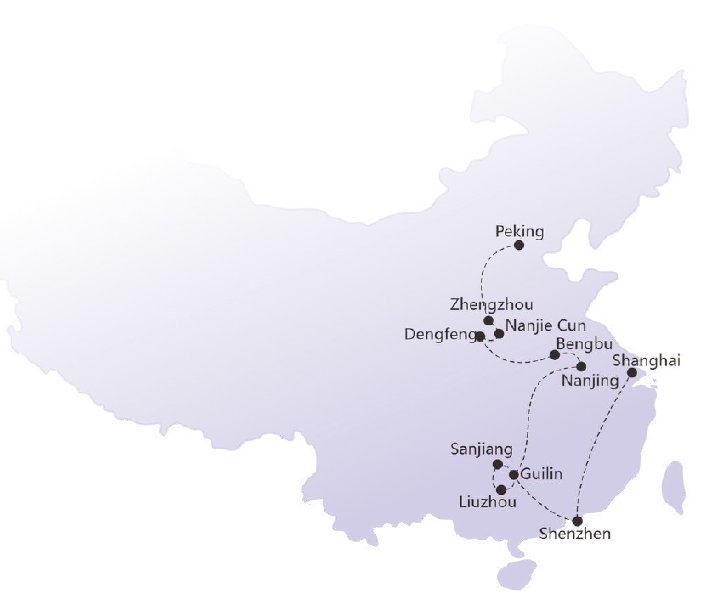|
CHINA-TRIP. A BRIEF LOOK BEHIND THE SCENES OF THE MIDDLE KINGDOM WITH JÜRGEN

Notes and provisional generalizations. Hans Thie, May 22, 2024
government and political system
- Government in Germany: legal framework, infrastructure, public services, social security
- The government in China also has to fulfill these four functions. But there are additional tasks and special features:
- Control of economic structures. Examples: e-mobility, renewable energies
- mastery and development of strategic technologies
- Dare to experiment and, if successful, spread it across the whole country. Experiments along the lines of “crossing the
river by feeling for stones“
- System of personnel selection based on strict success criteria. Incompetent failures like Andreas Scheuer and Annalena
Baerbock would have no chance
- Central priorities in general, rather vague language – concretization in provinces and cities according to local
conditions. Example: “Housing is for the people, not for profits” (Xi Jinping)
- Significantly more planning and implementation capacities than in Germany
- Land is 100% state-owned. Private individuals can only lease long-term, not buy
- Trial-and-Error as a Principle of Action in Administrations and Companies
- Companies and politics are geared towards cooperation. Politics also learns a lot from companies
- China has risen significantly in the Rule of Justice Index
- Intellectuals tend to be uneasy about Xi Jinping’s more rigid style of government, which restricts Chinese discourse
- Jürgen: “In China you cannot change the government, but you can change the politics. Here in Germany it is the other way round.”
Infrastructure and Cities
- Roads, railways, telecommunications excellently developed. 5G even in mountain villages
- China Highspeed Rail = world class. In 20 years, a dense network has emerged from virtually nothing.
- train stations such as airports
- On major roads there is often a strict separation of lanes for cars on the one hand and mopeds /
bicycles on the other
- China's big cities: clean, green and — thanks to e-mobility — quiet
- Mopeds, buses and taxis are almost completely electrified. Electric cars account for around 20%.
- In many parts, the cities are not particularly beautiful. Standard: 20- to 30-story buildings in light
ochre colors. Little architectural diversity
- Some city centers (Guilin) offer a festival of the senses in the evening
Public safety almost perfect.
- Cameras instead of police. You hardly see any police
- Telecommunication and Internet only with real names
- In the wild years of growth, problems with crime, corruption and child abduction
- Social Credit System as a reaction to bad products, poorly performing companies.
- Crime reduction in Shenzhen by 95%.
German China policy
- According to GIZ and AHK, Baerbock’s statements are at least unwise, and even tend to be catastrophic
- Germans in China are generally very dissatisfied with German China policy
- 200-300 projects of German-Chinese cooperation are practically paralyzed (environment, rule of law dialogue...)
Energy / Climate
- China and Germany today at the same fossil level: 80% of energy consumption
- China's 2030-2060 strategy. Emissions are to fall from 2030. Climate neutral from 2060. Both will probably
be achieved ahead of schedule. Emissions have already peaked.
Business
- Tough competition. “If you can make it there, you can make it everywhere.”
- China = Fitness Center for German and European Companies
- For German companies this means: take off in China or fail. Full commitment or be pushed to the sidelines.
- Not only the largest car market, but now also the largest and most innovative car production location
Huawei
- 207,000 employees. 50% of employees in R&D. Globally number four in R&D expenditure. Largest private
company in China
- World market leader in mobile communications infrastructure (especially antennas) and inverters
- Sanctions had little negative impact on the 5G sector
- Strong mobile phone position. Visit to one of many mobile phone production lines: 101 small machine cabinets
connected to the production line. One line produces 2,700 mobile phones a day
- Company is entirely owned by employees. Two thirds of profits are distributed to employees.
- The city of Shenzhen created the legal basis for the Huawei business model. Shares are given to those
who meet certain performance parameters.
- Three rotating CEOs. Change after six months. No business graduates on the board, but engineers and
tech experts.
- Huawei motto: “Expect the unexpected.” Black swans on the lakes of the company’s parks.
- Huawei also has many cooperation projects with German authorities and companies. "But in the interests
of our German partners, we are not allowed to talk about it."
- The distrust of Huawei has no basis in fact. Espionage is ruled out for technical reasons and because of constant
monitoring. In addition, Huawei would endanger its global market position and its
exports to 170 countries
- Before 2019, 30% of intermediate products/production resources came from the USA. Share today?
- Three major crises for the company. 1990: Import of telephone devices from Hong Kong stopped (Huawei started as
a telephone dealer). 1993: No loans from Chinese state banks. Around 2000 (??): No sales
of 3G technologies in China because the Chinese government did not rely on the Huawei
standard. Rescued by sales in Europe: same 3G(A) standard.
- Until 2010, the focus was on connectivity for carriers (telecom, etc.). After that, also: devices, computing,
cloud, digital power, intelligent automotive solutions.
- Shenzhen is unique in the world. From 30,000 inhabitants (1980) to 20 million today.
poverty reduction
- cadres in the villages
- Tea and Tourism
|
|
